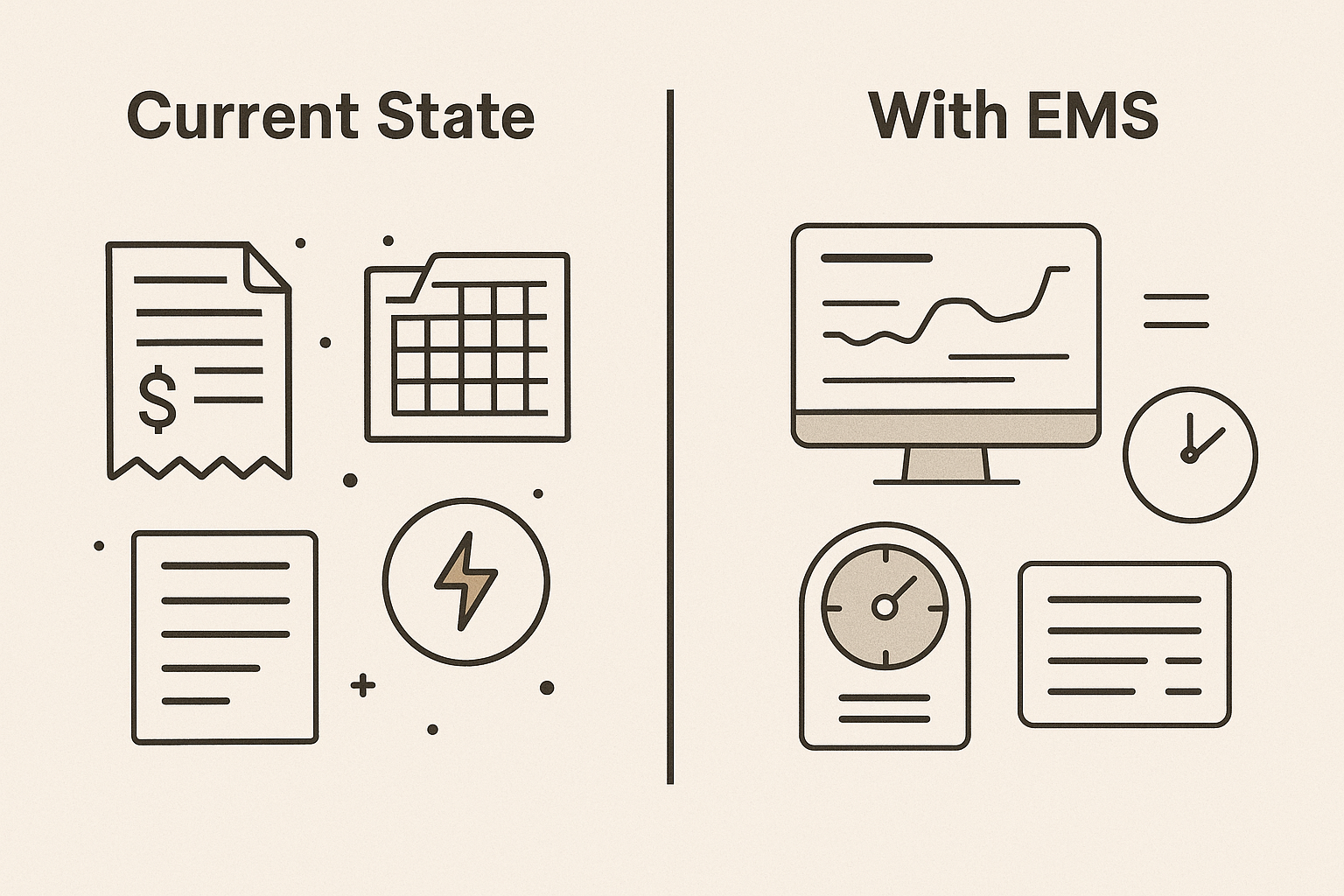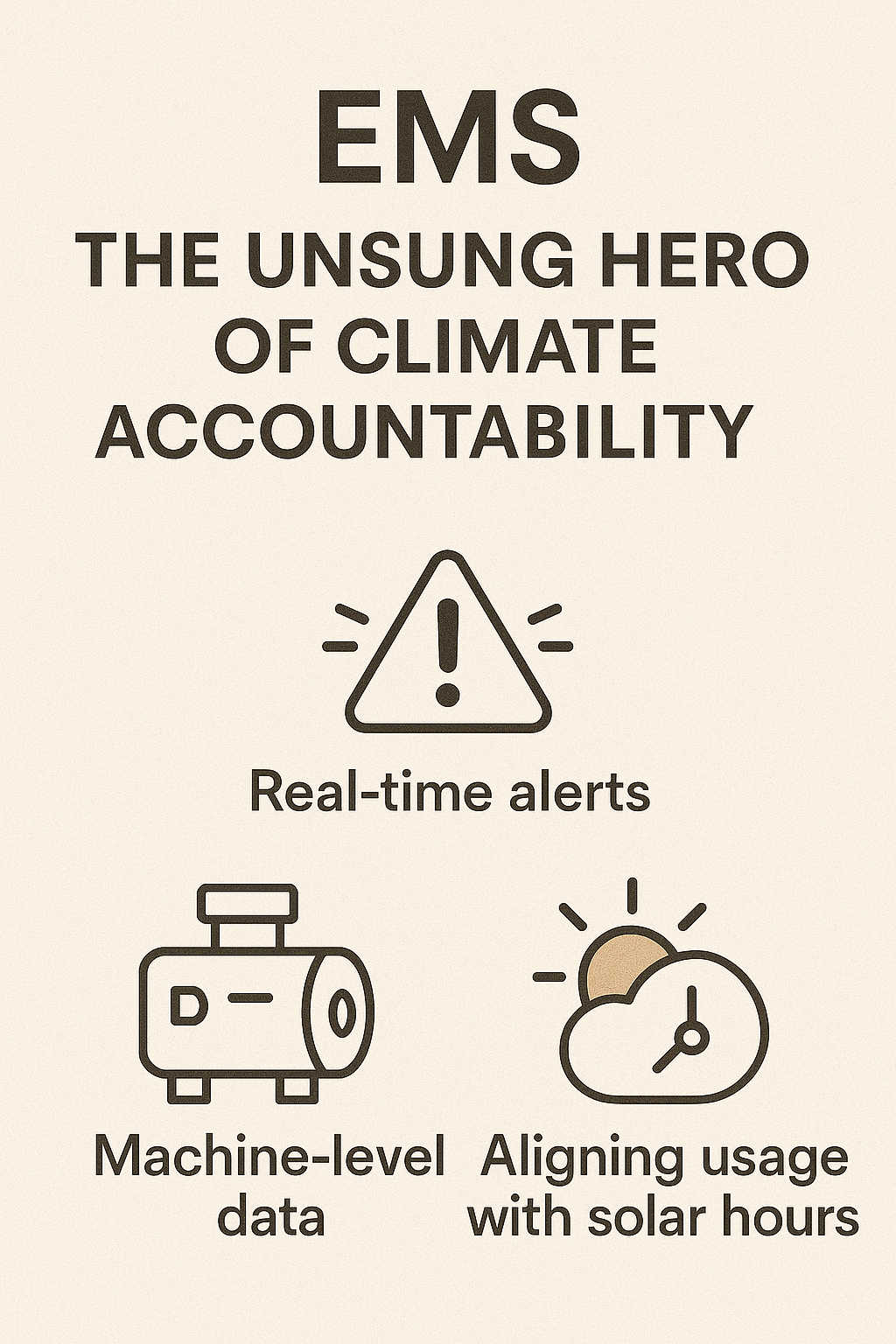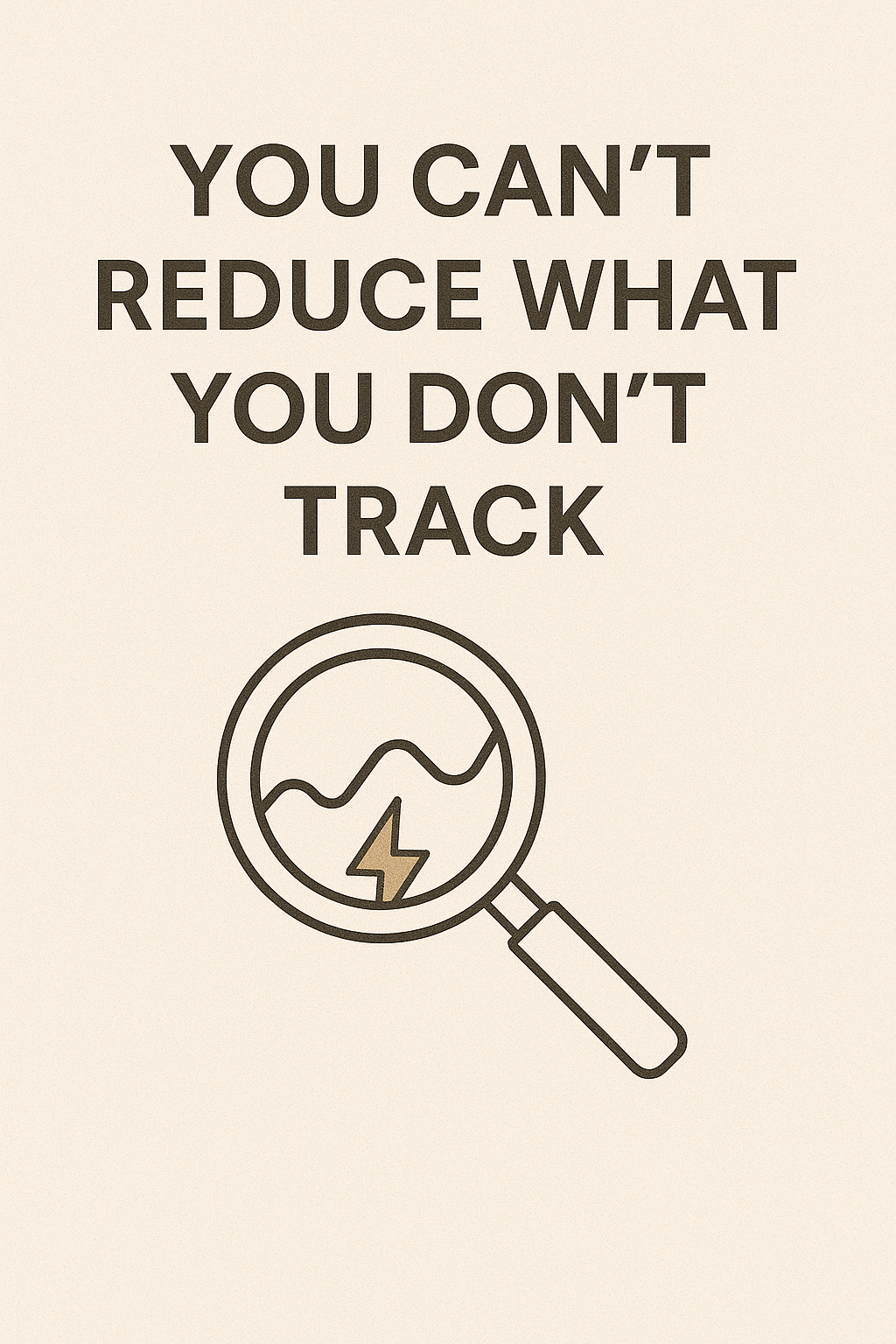In Malaysia, we’re blessed with affordable energy—perhaps too blessed. It’s like having a generous relative who keeps paying for lunch; eventually, you stop checking the bill. Many companies proudly announce their sustainability commitments while relying on utility bills from last quarter to track progress. It’s a bit like using last year’s photo to check if your diet is working today.
In boardrooms across the country, executives meticulously review detailed productivity metrics, sales forecasts, and market analyses—then turn to climate commitments and simply nod at last quarter’s utility bills. It’s like checking your watch once a month and expecting to be on time for every meeting.
Gentle reminder: you can’t improve what you don’t measure accurately.
We’ve all benefited from Malaysia’s affordable energy rates, but this blessing has quietly discouraged the precise monitoring that could unlock significant operational efficiencies. When sustainability initiatives are measured with real-time data rather than retroactive estimates, something remarkable happens: environmental goals align with financial ones.
An Energy Monitoring Solution isn’t just about environmental responsibility—it’s about discovering efficiency opportunities that translate to better margins, improved production, and yes, perhaps even those year-end bonuses we all quietly hope for. The question isn’t whether you can afford an Energy Monitoring Solution—it’s whether you’ve calculated the cost of not having one.
If your organization genuinely cares about climate action, starting with an Energy Monitoring Solution (EMS) isn’t just logical—it’s the only credible path forward. Here’s why.
The Foundation of Credible GHG Reporting: Energy Data
Scope 1 and 2 Emissions: The Controllable Core
While Scope 3 emissions (value chain) often account for 70–90% of a company’s total carbon footprint [1][2], Scope 1 (direct emissions) and Scope 2 (indirect emissions from purchased energy) represent the emissions most directly under an organization’s control. For energy-intensive sectors like manufacturing or utilities, Scope 1 and 2 can still dominate-making accurate tracking critical for regulatory compliance and operational efficiency [3][4].
Without granular energy monitoring, companies rely on:
- Monthly electricity bills (which average consumption over 30 days) [5][6].
- Generic grid emission factors (which ignore hourly renewable energy fluctuations) [3][4].
- Annual fuel purchase records (which miss seasonal usage spikes) [5].
This approach is akin to measuring rainfall with a teacup: you’ll know it rained, but not when, where, or how much.
Real-World Example:
A semiconductor manufacturer discovered that 40% of its Scope 2 emissions came from HVAC systems running overnight in empty offices-a flaw invisible on monthly bills. After installing an EMS, they slashed energy waste by 15% in six months [7][8].
The Irony of Interlinked Emissions:
Your organization’s Scope 3 emissions (e.g., purchased materials, logistics) are your suppliers’ Scope 1 and 2 emissions. Yet, only 10% of suppliers measure emissions accurately, often relying on estimates or outdated factors [4]. This creates a vicious cycle:
- Your carbon footprint hinges on their unverified data.
- Their inefficiencies become your reporting liability.
If suppliers adopted EMS to track their Scope 1/2 emissions, your Scope 3 reporting would transform from guesswork to precision. For example, a textile supplier using EMS to optimize dyeing machines could cut its natural gas use by 20%, directly lowering your upstream emissions [16].
Why This Matters for Your GHG Strategy
- Supplier Engagement: Over 70% of companies struggle to collect reliable Scope 3 data due to supplier gaps [4]. EMS adoption across your supply chain turns opaque emissions into actionable insights.
- Regulatory Preparedness: The EU’s CSRD and similar frameworks now mandate Scope 3 disclosures. EMS-equipped suppliers simplify compliance [17].
- Collective Impact: When suppliers reduce their Scope 1/2 via EMS, your Scope 3 shrinks organically-creating a ripple effect of accountability [18].
Why Start with an EMS?
1. Granular Data: The Currency of Trust
An EMS captures energy consumption in real time, down to individual machines or production lines. This granularity is critical for:
- Precise emissions calculations aligned with GHG Protocol standards [3][6].
- Identifying hidden waste (e.g., machinery left idle but powered) [8][9].
- Building stakeholder trust through auditable, transparent data [5][10].
Case in Point:
A food processing plant reduced its Scope 2 emissions by 22% after its EMS revealed that 18% of its energy was consumed during peak grid periods (when fossil fuels dominated the energy mix) [8][11].
2. Operational Efficiency: Where Emissions Meet Economics
EMS isn’t just about compliance-it’s about turning data into action. Consider:
- A textile mill used EMS data to retrofit inefficient motors, cutting energy costs by RM 1.2 million annually [11].
- A data center avoided RM 3.8 million in peak demand charges by load-shifting operations during low-tariff hours [7][11].
The Hidden ROI:
For every RM 1 spent on EMS, manufacturers average RM 4–7 in energy savings-a return even the most optimistic carbon offset projects can’t match [7][11].
3. Regulatory Compliance: Avoiding the “Greenwashing” Trap
Malaysia’s Energy Efficiency and Conservation Act (EECA) mandates large energy consumers to implement Energy Management Systems (EnMS), with fines up to RM 50,000 for non-compliance [12][10]. Without EMS, organizations risk:
- Inaccurate reporting (e.g., using outdated grid emission factors) [3][6].
- Reputational damage from perceived greenwashing [1][2].
The LED Light Fallacy:
Publicly listed companies often tout “sustainability wins” like switching to LED lights or installing solar panels. Yet, without EMS, they can’t verify if these measures actually reduced emissions or just shifted costs. One firm claimed a 12% emissions reduction-until an EMS revealed a faulty meter had undercounted natural gas use by 18% [8][2].
The Manual Data Trap:
Engineering teams drowning in spreadsheets waste 37+ hours monthly manually compiling energy data [7]. EMS automates this, freeing them to focus on strategic improvements-not data entry.

The Irony of “Sustainability Theater”
Many organizations invest heavily in ESG consultants or offsets while neglecting EMS. It’s like splurging on organic groceries but storing them in a broken fridge-wasted effort.
The Harsh Reality:
- GHG platforms without EMS = Polished reports built on shaky data [1][13].
- EMS + GHG integration = Credible, actionable insights [7][9].



How EMS Future-Proofs Your Climate Strategy
Beyond Compliance: The 24/7 Carbon-Free Era
As global standards evolve toward 24/7 carbon accounting (matching energy use with hourly renewable availability), EMS becomes indispensable. For example:
- Automated load-shifting: EMS can reroute energy use to times when the grid is 50% solar-powered [9][14].
- Renewable integration: Pair EMS with onsite solar to track real-time renewable contributions [15][14].
The Data Dividend:
Companies with EMS can:
- Sell excess renewable energy back to the grid [14].
- Access green financing with verified emissions data [10][2].
- Preempt future regulations (e.g., carbon taxes) [10][4].
Conclusion: Measure Before You Manage
Sustainability isn’t a buzzword-it’s a discipline. And like any discipline, it starts with measurement.
For organizations that truly care about climate action, EMS isn’t an optional tool-it’s the foundation of credibility. Without it, GHG reporting is just storytelling. With it, you gain the power to turn pledges into progress.
Final Thought:
“You can’t reduce what you don’t track.” Start with EMS, and let your data-not estimates-tell your sustainability story.
Call to Action:
Ready to transform your climate strategy from guesswork to precision? [Explore our EMS solutions] or [schedule a free energy audit] to discover how granular data can unlock efficiency, compliance, and trust.
Because the planet deserves more than good intentions-it demands proof.
Innovast: Empowering Energy Efficiency and Sustainability
At Innovast, we specialize in transforming energy management challenges into opportunities for growth and sustainability. As a leading energy solutions provider in Malaysia, we offer cutting-edge technologies, including IoT-driven energy monitoring, AI-powered analytics, and cloud-based energy management systems. Our expertise in EECA 2024 compliance ensures that businesses not only meet regulatory requirements but also unlock significant cost savings and operational efficiencies.
With a commitment to driving sustainability, Innovast partners with organizations to achieve their energy goals while contributing to Malaysia’s carbon neutrality targets. Whether you’re navigating the complexities of energy audits, implementing an EnMS, or exploring renewable energy integration, Innovast is your trusted partner for a smarter, greener future.
Contact us today to learn how we can help your business thrive in the era of energy efficiency. Visit Innovast or call us at +60 12 355 6214.
- https://www.terrascope.com/blog/overcoming-challenges-in-understanding-and-quantifying-scope-3-emissions-for-large-enterprises
- https://normative.io/insight/scope-1-2-3-emissions-explained/
- https://envoria.com/insights-news/what-are-the-ghg-protocol-and-scope-emissions
- https://www.nationalgrid.com/stories/energy-explained/what-are-scope-1-2-3-carbon-emissions
- https://www.epa.gov/climateleadership/scope-1-and-scope-2-inventory-guidance
- https://ghgprotocol.org/sites/default/files/Guidance_Handbook_2019_FINAL.pdf
- https://www.esgdive.com/spons/new-survey-reveals-impressive-roi-and-substantial-savings-with-energy-manag/715448/
- https://www.aceee.org/files/proceedings/1994/data/papers/SS94_Panel5_Paper28.pdf
- https://www.mdpi.com/1996-1073/17/19/4941
- https://www.st.gov.my/contents/2024/EECA/BI – Energy Efficiency and Conservation Act 2024 – Act 861.pdf
- https://legacyllcelectric.com/what-is-the-roi-on-energy-management-systems/
- https://www.st.gov.my/contents/2025/EECA/03-20250404 GUIDELINES ON ENMS.pdf
- https://ghginstitute.org/2024/04/02/myth-busting-are-corporate-scope-3-emissions-far-greater-than-scopes-1-or-2/
- https://www.eria.org/RPR_FY2015_no.17_Chapter_4.pdf
- https://www.sciencedirect.com/science/article/pii/S2215016124001158
- https://plana.earth/academy/what-are-scope-1-2-3-emissions
- https://www.carbontrust.com/en-as/our-work-and-impact/guides-reports-and-tools/what-are-scope-3-emissions-and-why-do-they-matter
- https://ghgprotocol.org/sites/default/files/2022-12/FAQ.pdf












1 thought on “Why Organizations That Truly Care About Verified GHG Data and Climate Action Should Start with an Energy Monitoring Solution (EMS)”
Pingback: Energy-Sustainability Integration: Bridging the Gap in Malaysian Corporate Strategy